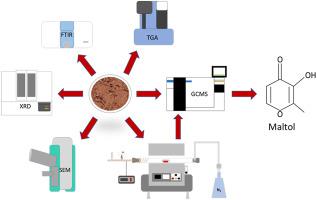Biomass & Bioenergy ( IF 5.8 ) Pub Date : 2023-05-06 , DOI: 10.1016/j.biombioe.2023.106822 Ola Ismail , Labeeb Ali , Mohamed Shafi Kuttiyathil , Muhammad Z. Iqbal , Abbas Khaleel , Mohammednoor Altarawneh

|
In arid and semiarid environments, bio-oil extraction from environmentally favorable and waste biomass is presently used as a mainstream strategy for the development of sustainable sources of energy. In keeping with this, we provide a thorough analysis of the pyrolysis of date palm pits here, focusing particularly on relevant thermal degradation profiles and pyrolytic products over a wide temperature range. Pyrolysis experiments were performed using a single-stage reactor at several temperature intervals. The temperature ranges were chosen following mass loss profiles of date pit biomass obtained by thermogravimetric analyzer (TGA) analysis. Density functional theory (DFT) calculations map out reaction pathways that dictate the decomposition of two model compounds that represented oxygen and nitrogen content in the collected condensed and non-condensed fractions. In-depth temperature-dependent profiles of pyrolytic products are thoroughly presented and analyzed. Analysis of products indicates the generation of a wide spectra of green diesel's ingredients of (i.e., long aliphatic compounds) and transportation fuels additives (alkylated benzenes). Aromatic compounds attain the highest fractions in the collected bio-oil at investigated temperature windows. Glucose derivatives appear in appreciable loads in the non-condensable fractions. The obtained mass loss curves reflect degradation curves for the most prominent biomass structural components; namely lignocellulosic, hemicellulose, and lignin. Findings presented herein shall be helpful to develop pyrolysis technologies that are suited for niche categories of biomass found in arid and semiarid regions where cultivation of standard energy crops is impractical.
中文翻译:

枣核热解增值产品的形成:实验-DFT 相结合的方法
在干旱和半干旱环境中,从对环境有利的废生物质中提取生物油目前被用作开发可持续能源的主流策略。为了与此保持一致,我们在这里对枣椰核的热解进行了全面分析,特别关注相关的热降解曲线和宽温度范围内的热解产物。使用单级反应器在几个温度间隔下进行热解实验。根据通过热重分析仪 (TGA) 分析获得的枣核生物质的质量损失曲线,选择温度范围。密度泛函理论 (DFT) 计算绘制出反应路径,这些路径指示两种模型化合物的分解,这两种模型化合物代表所收集的冷凝和非冷凝馏分中的氧和氮含量。深入介绍和分析了热解产品的温度依赖性曲线。产品分析表明会生成广谱绿色柴油成分(即长链脂肪族化合物)和运输燃料添加剂(烷基化苯)。在调查的温度窗口中,芳香族化合物在收集的生物油中达到最高分数。葡萄糖衍生物以可观的负载出现在不可凝馏分中。获得的质量损失曲线反映了最突出的生物质结构组分的降解曲线;即木质纤维素、半纤维素和木质素。本文提出的研究结果将有助于开发适用于标准能源作物种植不切实际的干旱和半干旱地区发现的生物质利基类别的热解技术。











































 京公网安备 11010802027423号
京公网安备 11010802027423号